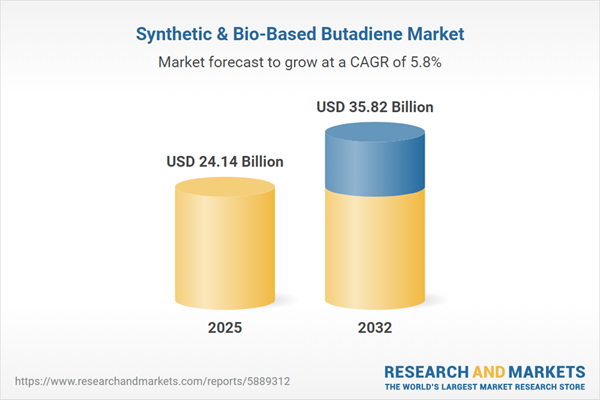Speak directly to the analyst to clarify any post sales queries you may have.
The synthetic and bio-based butadiene market is rapidly evolving as companies prioritize sustainability and secure supply chains to meet regulatory and commercial imperatives. Senior decision-makers face a dynamic environment requiring adaptable strategies, sustainable sourcing, and operational innovation.
Market Snapshot: Growth and Dynamics in the Synthetic & Bio-Based Butadiene Market
With a current valuation of USD 22.83 billion, the global synthetic & bio-based butadiene market continues to experience steady expansion, projected to reach USD 24.14 billion by 2025 and USD 35.82 billion by 2032. Growth is underpinned by accelerated integration of renewable feedstocks and strict adherence to regulatory compliance. Consistent demand from polymer production, automotive manufacturing, and broader industrial use keeps driving the sector forward. Digital transformation is influencing supply chain responsiveness and streamlining demand forecasting. As market boundaries expand, sustainability increasingly forms a core component of value propositions, supporting both regulatory obligations and commercial objectives.
Scope & Segmentation
This report offers senior leaders a strategic framework to navigate the evolving synthetic & bio-based butadiene landscape. Primary focus areas include:
- Feedstock Types: Bio-based butadiene sourced from corn or wood waste supports environmental commitments, while petroleum-based options like butane and tar enhance process reliability at scale.
- Technology Platforms: Advances such as catalytic dehydrogenation, high-efficiency catalysts, and steam cracking enable process gains and compliance improvements throughout the production lifecycle.
- Purity Categories: Chemical and polymer grades are tailored to address both bulk manufacturing requirements and specialty application needs across industrial segments.
- End-Use Industries: Key areas of application include ABS and SAN resins, automotive parts, healthcare elastomers, synthetic rubber, footwear, and diverse consumer goods, illustrating the expanding industrial relevance of butadiene products.
- Geographies: The report reviews strategic implications across the Americas, Europe, Middle East & Africa, and Asia-Pacific, focusing on how region-specific policy, supply chain architecture, and partnership models shape effective entry and expansion strategies.
- Profiled Companies: Analysis benchmarks leading organizations including China Petroleum & Chemical Corporation, LyondellBasell, Dow Inc., Exxon Mobil, Royal Dutch Shell, Saudi Basic Industries, Braskem, INEOS Group, PetroChina, and Versalis, highlighting ongoing advances in compliance and innovation.
Key Takeaways for Senior Decision-Makers
- Sourcing strategies now integrate lifecycle thinking and circularity, aligning with sustainability metrics and enabling enhanced supplier performance measurement frameworks.
- Resilient, agile supply chains are crucial for managing policy changes and supporting operations in multiple jurisdictions, enabling rapid compliance and operational flexibility.
- Process innovation and adoption of advanced manufacturing technologies deliver measurable gains in emissions reduction and efficiency throughout the value chain.
- Continuous investment in R&D elevates product quality and supports strategic alliances in automotive, consumer, and healthcare applications.
- Regional strategies emphasize capital allocation in North America, decarbonization initiatives in EMEA, and digital and technology integration in Asia-Pacific to boost market agility and responsiveness.
Tariff Impact: Trade and Operations Strategy
Forthcoming U.S. tariff changes in 2025 are prompting organizations to adapt their trade and operational models within the synthetic & bio-based butadiene sector. These anticipated shifts drive proactive adjustments in logistics, supplier contracting, and risk management. A strong focus on local sourcing and broader supplier networks enables companies to absorb pricing volatility and respond effectively as policy conditions develop.
Methodology & Data Sources
The report builds its findings on a triangulation of insights from industry executives, sector specialists, and confirmed market datasets. This robust methodology delivers actionable strategic intelligence for all market participants, ensuring the highest relevance to procurement and supply chain leadership.
Why This Report Matters
- Empowers executive teams to harmonize procurement and sourcing strategies with evolving regulations and business process mandates in a highly competitive sector.
- Supports robust scenario planning and risk assessment by providing the latest intelligence on regulatory changes and market movement.
- Facilitates well-informed sustainability investments and data-driven decision-making to build organizational agility and resilience in volatile conditions.
Conclusion
This report equips leaders to strengthen strategic direction and operational resilience. Forward-looking approaches support successful navigation of market transitions, reinforcing organizational competitiveness and decisiveness in an evolving business climate.
Additional Product Information:
- Purchase of this report includes 1 year online access with quarterly updates.
- This report can be updated on request. Please contact our Customer Experience team using the Ask a Question widget on our website.
Table of Contents
3. Executive Summary
4. Market Overview
7. Cumulative Impact of Artificial Intelligence 2025
Companies Mentioned
The companies profiled in this Synthetic & Bio-Based Butadiene market report include:- China Petroleum & Chemical Corporation
- LyondellBasell Industries N.V.
- Dow Inc.
- Exxon Mobil Corporation
- Royal Dutch Shell PLC
- Saudi Basic Industries Corporation
- Braskem S.A.
- INEOS Group Holdings S.A.
- PetroChina Company Limited
- Versalis S.p.A.
Table Information
| Report Attribute | Details |
|---|---|
| No. of Pages | 187 |
| Published | November 2025 |
| Forecast Period | 2025 - 2032 |
| Estimated Market Value ( USD | $ 24.14 Billion |
| Forecasted Market Value ( USD | $ 35.82 Billion |
| Compound Annual Growth Rate | 5.7% |
| Regions Covered | Global |
| No. of Companies Mentioned | 11 |









